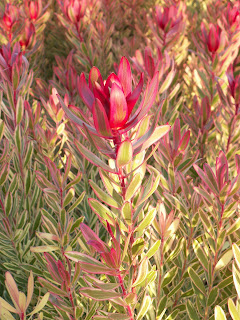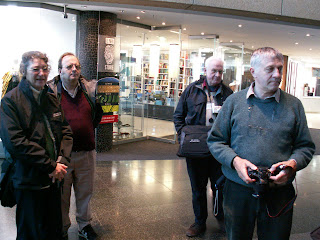








From Taupo Tardis to the reluctant Geezer Monday 19 May
Last night the membership sub-committee met for the final time prior to our Board meeting in Auckland. We have been very effectively chaired for the past twelve months by Bill Barr. Bill will be leaving the committee at the end of the year and as a relative new comer to the International Board , I would like to put on record that he will be sorely missed.
The Bayview Chateau hotel sits majestically at the base of Mt Ruapehu. Our early morning guide and general manager of Taupo Native Plants , Philip Smith, remarked that he was relieved to see us survive the night, as the hotel is in the direct firing line of this very active volcano.
For those of you who feel that the tour is all about indulgence, drinking fine wines and knocking back boutique beers, please cut us some slack, as this morning we are up early and out by 7.30 am , in close to sub zero conditions, for a walk on the great mountain. Philip, who in a previous career worked for the Department of Conservation and now runs a leading native plant nursery, guided us through the native flora, as we spent the next two hours on the hillside. The flora is relatively impoverished as it is regularly covered in ash and larva. Predominant species include hebe, brachyglottis, celmisia, griselinia and stipa. Calluna vulgaris is prevalent, and is now considered an invasive weed. It was introduced to the area as a food source for grouse- they didn’t survive but the heather now thrives. We then moved on up to the ski centre, passing a mountain gulley full of one of NZ’s most spectacular plants, the mountain cabbage tree – Cordyline indivisa. This is when I begin to really get excited. It’s looks like corydline australis but on steroids and reminds me of the giant senecios found on kilimanjaro.
Philip is currently undertaking a large revegetation project across the ski runs. Each year just before the snows arrive matting is placed over the runs to protect the alpine plants that are slowly re-covering the ground. Included from this walk is a picture of GB&I’s International representatives Pete Bingham and the author. Pete often reminds me that he is from the low country, being a fen boy, so although we were at now more than 5000 feet , I think Pete was feeling a little light headed.
Next stop Taupo Native Plants. Taupo is a thriving resort town much frequented by the kiwi. The town is situated on the edge of Lake Taupo which is the largest lake in the southern hemisphere and was formed thousands of years ago as a result of three massive volcanic eruptions. It is still possible to bathe in hot spring water rising from the lake floor.
It was great to return to Taupo Native Plants. Four years back I spent a month working on Philip’s nursery, getting to grips with the native flora. Philip provided me with opportunities to look beyond the nursery and so I got involved with the revegetation of a river bank, I went out collecting seed and cutting material, visited other nurseries and walked the Tongariro Crossing, one of NZ top ten ‘tramps’ I have much to be thankful.
Philip is another one of those great characters, opinionated but open minded , someone always wishing to challenge himself and others and it is all done with a great deal of good humour. The nursery has literally doubled in size as it now works off a second site in Auckland and produces in the region of two million native plants annually. Ninety-seven percent of these are raised from seed.
Much of the material grown is eco sourced which provides the opportunity of supplying plant material from a number of different locations and environments from right across New Zealand , this is what many projects demand when re-vegetating areas with native flora.
The nursery covers an area of fifty acres and is at the centre of the most active geo thermal area in New Zealand. The nursery makes use of this and all the nursery heating is supplied via the heated waters. Most were fascinated by the steam rising from out the ground and the all pervading sulphurous odour. Of particularly note was the steaming tardis located in one corner of the nursery.
After lunch we drove North to Rotorua , stopping off briefly to visit the Huka falls. Rotorua is the Maori cultural capital of New Zealand and the home of a number of geothermal parks. We visited a Maori village where, after much coaxing, the two geezers spluttered into life.
Last night the membership sub-committee met for the final time prior to our Board meeting in Auckland. We have been very effectively chaired for the past twelve months by Bill Barr. Bill will be leaving the committee at the end of the year and as a relative new comer to the International Board , I would like to put on record that he will be sorely missed.
The Bayview Chateau hotel sits majestically at the base of Mt Ruapehu. Our early morning guide and general manager of Taupo Native Plants , Philip Smith, remarked that he was relieved to see us survive the night, as the hotel is in the direct firing line of this very active volcano.
For those of you who feel that the tour is all about indulgence, drinking fine wines and knocking back boutique beers, please cut us some slack, as this morning we are up early and out by 7.30 am , in close to sub zero conditions, for a walk on the great mountain. Philip, who in a previous career worked for the Department of Conservation and now runs a leading native plant nursery, guided us through the native flora, as we spent the next two hours on the hillside. The flora is relatively impoverished as it is regularly covered in ash and larva. Predominant species include hebe, brachyglottis, celmisia, griselinia and stipa. Calluna vulgaris is prevalent, and is now considered an invasive weed. It was introduced to the area as a food source for grouse- they didn’t survive but the heather now thrives. We then moved on up to the ski centre, passing a mountain gulley full of one of NZ’s most spectacular plants, the mountain cabbage tree – Cordyline indivisa. This is when I begin to really get excited. It’s looks like corydline australis but on steroids and reminds me of the giant senecios found on kilimanjaro.
Philip is currently undertaking a large revegetation project across the ski runs. Each year just before the snows arrive matting is placed over the runs to protect the alpine plants that are slowly re-covering the ground. Included from this walk is a picture of GB&I’s International representatives Pete Bingham and the author. Pete often reminds me that he is from the low country, being a fen boy, so although we were at now more than 5000 feet , I think Pete was feeling a little light headed.
Next stop Taupo Native Plants. Taupo is a thriving resort town much frequented by the kiwi. The town is situated on the edge of Lake Taupo which is the largest lake in the southern hemisphere and was formed thousands of years ago as a result of three massive volcanic eruptions. It is still possible to bathe in hot spring water rising from the lake floor.
It was great to return to Taupo Native Plants. Four years back I spent a month working on Philip’s nursery, getting to grips with the native flora. Philip provided me with opportunities to look beyond the nursery and so I got involved with the revegetation of a river bank, I went out collecting seed and cutting material, visited other nurseries and walked the Tongariro Crossing, one of NZ top ten ‘tramps’ I have much to be thankful.
Philip is another one of those great characters, opinionated but open minded , someone always wishing to challenge himself and others and it is all done with a great deal of good humour. The nursery has literally doubled in size as it now works off a second site in Auckland and produces in the region of two million native plants annually. Ninety-seven percent of these are raised from seed.
Much of the material grown is eco sourced which provides the opportunity of supplying plant material from a number of different locations and environments from right across New Zealand , this is what many projects demand when re-vegetating areas with native flora.
The nursery covers an area of fifty acres and is at the centre of the most active geo thermal area in New Zealand. The nursery makes use of this and all the nursery heating is supplied via the heated waters. Most were fascinated by the steam rising from out the ground and the all pervading sulphurous odour. Of particularly note was the steaming tardis located in one corner of the nursery.
After lunch we drove North to Rotorua , stopping off briefly to visit the Huka falls. Rotorua is the Maori cultural capital of New Zealand and the home of a number of geothermal parks. We visited a Maori village where, after much coaxing, the two geezers spluttered into life.














































